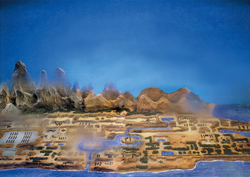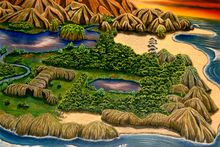| Don't like the ads? Then create an account! Users with accounts have more options than anonymous users. |
Death Mountain Area
| Death Mountain Area | |
|---|---|
 Artwork of Death Mountain Area in The Legend of Zelda | |
| First appearance | The Legend of Zelda (1986) |
| Latest appearance | Hyrule Warriors: Definitive Edition (2018) |
| Greater location | Hyrule |
- Not to be confused with Death Mountain.
Death Mountain Area[1] is a portion of Hyrule in Zelda II: The Adventure of Link that makes up the entirety of the overworld for the first The Legend of Zelda game. It encompasses the southern portion of Death Mountain itself as well as the area surrounding it, with the rest of the mountain being accessible through Spectacle Rock. While the specific "Death Mountain Area" has not been used since, aspects of it have appeared across Hyrule, with the area surrounding the mountain including locations like Death Mountain Trail and the Eldin region.
History[edit]
The Legend of Zelda series[edit]
The Legend of Zelda[edit]

In The Legend of Zelda, Death Mountain Area is not specifically named, but makes up the entire explorable area of Hyrule. No towns are located within, so its sparse human inhabitants shelter in caves and holes in the ground, usually covered by bushes, rocks, or Armos-like statues. The humans found include various merchants who will sell Link items, old men who will either give Link items or advice, allow him to play a money-making game, or charge him for destroying their doors, and old women who sell Water of Life or information. Underneath the land, a vast monster-filled labyrinth sprawls, with various entrances to unconnected portions scattered across the surface, some of which require specific items to uncover.
Most of the southern section is lightly forested, the western third of which is dried, brown, and contains the confusing Lost Woods. The southeastern segment contains a coastline bordering the forest. Along the center section lies a small graveyard to the west, a lake and a desert in the center, and some more forest and coastline to the east. The northern section is almost entirely made up of the base of Death Mountain itself, with a few landmarks such as Spectacle Rock and the Lost Hills.
The various environments are filled with many types of monsters, some of which are simply wild creatures and others working for Ganon. Many are specific to certain areas, such as Molblins appearing in forests and Lynels on the mountain. Certain Molblins who do not wish to fight instead hide in caves like the humans, bribing Link with Rubies should he find them.
Zelda II: The Adventure of Link[edit]
In Zelda II: The Adventure of Link, Death Mountain Area is merely the southwesternmost portion of Hyrule, and relatively small compared to most other regions. It can be entered through the network of caves across Death Mountain accessible from the south side of the Water Town of Saria. Due to the map being more zoomed-out, it lacks detail, but is still recognizable. The lake, western forest, graveyard, and Spectacle Rock are still visible, with the last keeping its entrance to Death Mountain's interior, where Link can find the hammer in the east half and a Magic Container in the west half.
Hyrule Warriors[edit]
In Hyrule Warriors, the original overworld map from The Legend of Zelda is used as a world map for Adventure Mode, with its various secrets intact.
Names in other languages[edit]
| Language | Name | Meaning |
|---|---|---|
| Japanese | デスマウンテンエリア[2] Desumaunteneria |
Death Mountain Area |